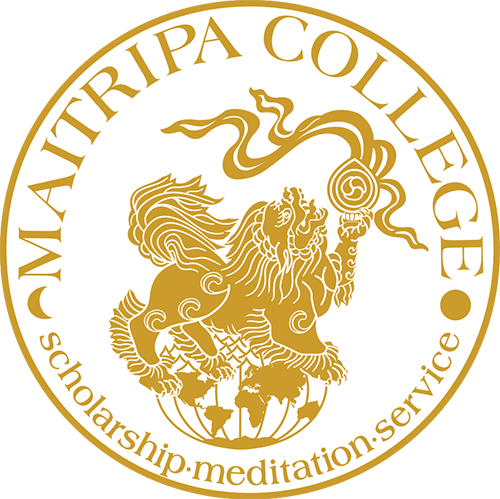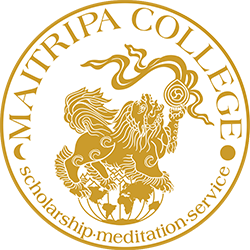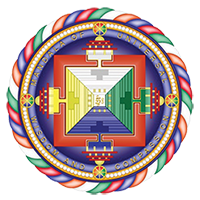Something magically created through the force of a mantra May appear as if it had the character of an elephant, But there is merely an appearing aspect there And no elephant at all exists. [27]
The elephant is the imaginary nature, Its appearance is the other-dependent, And the nonexistence of the elephant there Is held to be the perfect. [28] –Vasubandhu, “Instruction on the Three Natures” (Brunnhölzl, Straight from the Heart)
JABL Subject Headings
Definitions
Chittamatra
སེམས་ཙམ་པ་
sems-tsam-pa
cittamātra
- A Mahayana school of Indian Buddhism that does not assert external phenomena, but which does assert the true existence of dependent phenomena. One of the four Indian Buddhist tenet systems studied by all traditions of Tibetan Buddhism. The Mind-Only School.
Synonym: Mind-only School (Berzin Definitions) - Mind-Only School; Chittamātra; Proponent of Mind Only (Hopkins)
Yogachara
རྣལ་འབྱོར་སྤྱོད་པ་
rnal ‘byor spyod pa
yogācāra
- Another name for the Chittamatra school of Indian Buddhism. (Berzin Definitions)
- Yogāchāra; practice of yoga (Hopkins)
Cognition-only (Hopkins)
rnam pa rig pa tsam
རྣམ་པ་རིག་པ་ཙམ་
vijñaptimātra
- ‘Mere representation’; the Yogācāra theory that the contents of everyday, unenlightened experience are merely a false superimposition upon actuality of dualistic concepts generated by the mind that prevent direct experience of reality as it truly is (yathā-bhūta). Some later forms of Yogācāra lend themselves to an idealistic interpretation of this theory but such a view is absent from the works of the early Yogācārins such as Asaṇga and Vasubandhu. (A Dictionary of Buddhism, Oxford University Press)
Sutra Sources
Samdhinirmocana Sutra
Unraveling the Intent
དགོངས་པ་ངེས་འགྲེལ།
dgongs pa nges ‘grel
Saṃdhinirmocana
Tibetan
- Buddhavacana Translation Group. 2020. The Noble Great Vehicle Sūtra “Unraveling the Intent.” 84000: Translating the Words of the Buddha. 84000
- Cleary, Thomas F, trans. 1995. Buddhist Yoga: A Comprehensive Course. Shambhala. JABL
- Keenan, John P., trans. 2000. The Scripture on the Explication of Underlying Meaning. Numata Center for Buddhist Translation and Research. WorldCat
- Powers John, trans. 1995. Wisdom of Buddha: The Saṁdhinirmocana Sūtra. Dharma Publishing. JABL
Lankavatara Sutra
Discourse of the Descent into Laṅka
ལང་ཀར་བཤེགས་པའི་མདོ་
lang kar bshegs pa’i mdo
Laṅkāvatāra Sūtra
Tibetan
- Sutton, Florin Giripescu, trans. 1991. Existence and Enlightenment in the Laṅkāvatāra-Sūtra: A Study in the Ontology and Epistemology of the Yogācāra School of Mahāyāna Buddhism. SUNY Press. JABL
- Suzuki, Daisetz Teitaro, trans. 1999. The Lankavatara Sutra: A Mahayana Text: Translated for the First Time from the Original Sanskrit. Motilal Banarsidass. JABL
Indian Sources
Transmitted from Maitreyanātha to Asaṅga
- Maitreyanātha, Arya Vimuktisena (Vrtti), Haribhadra (Aloka), and Gareth Sparham, trans. 2015. Abhisamayālaṃkāra with Vr̥tti and Ālokā. V. 1-4. Jain Publishing Company. JABL
- Maitreyanātha, Jeffrey Hopkins and Jongbok Yi, trans. 2015. Maitreya’s Ornament for the Clear Realizations. UMA Institute for Tibetan Studies. UMA-Tibet
- Asaṅga, Maitreyanātha, Robert A. F. Thurman, L. Jamspal, and Vasubandhu. 2004. The Universal Vehicle Discourse Literature = Mahāyānasūtrālaṁkāra. American Institute of Buddhist Studies. JABL
- Maitreyanātha, Gzhan-dga Gzhan-phan-chos-kyi-snaṅ-ba, and Lama Mipham. 2014. Ornament of the Great Vehicle Sūtras: Maitreya’s Mahāyānasūtrālaṃkāra with Commentaries by Khenpo Shenga and Ju Mipham. Snow Lion. JABL
- Maitreyanātha, Vasubandhu, Sthrimathli, and Th. Stcherbatsky, trans. 1992. Madhyānta-Vibhāga: Discourse on Discrimination between Middle and Extremes Ascribed to Boddhisattve Maitreya and Commented by Vasubandhu and Sthiramati. Sri Satguru Publications. JABL
- Vasubandhu and Stefan Anacker. 1984. Seven Works of Vasubandhu: The Buddhist Psychological Doctor. Motilal Banarsidass. JABL (archive.org)
Asaṅga
Bodhisattvabhūmiḥ
Bodhisattva Grounds
ས་ལས་བྱང་ཆུབ་སེམས་དཔའི་ས་
sa las byang chub sems dpa’i sa
Tibetan
- Asaṅga and Artemus B. Engle, trans. 2016. The Bodhisattva Path to Unsurpassed Enlightenment: A Complete Translation of the Bodhisattvabhūmi. Translated by Artemus B Engle. Snow Lion. JABL
- Asaṅga and Janice Willis. 1979. On Knowing Reality: The Tattvārtha Chapter of Asaṅga’s Bodhisattvabhūmi. Columbia University Press. JABL
Mahāyānasamgraha
Compendium of the Mahāyāna
ཐེག་པ་ཆེན་པོ་བསྡུས་པ
theg pa chen po bsdus pa
Tibetan
- Asaṅga, Karl Brunnhölzl, and Tsadra Foundation. 2018.A Compendium of the Mahāyāna: Asaṅga’s Mahāyānasaṃgraha and Its Indian and Tibetan Commentaries. Snow Lion
Vasubandhu
- Vasubandhu and Karl Brunnhölzl, trans. 2007. Straight from the Heart: Buddhist Pith Instructions. Snow Lion. JABL
- Vasubandhu and Stefan Anacker. 1984. Seven Works of Vasubandhu: The Buddhist Psychological Doctor. Motilal Banarsidass. JABL (archive.org)
Viṃśatikāvṛtti
Twenty Verses and Commentary
Tibetan
- Vasubandhu and Stefan Anacker. 1984. Seven Works of Vasubandhu: The Buddhist Psychological Doctor. Motilal Banarsidass. JABL (archive.org)
Viṃśatikāvṛtti
Thirty Verses and Commentary
ཉི་ཤུ་པའི་འགྲེལ་པ་
nyi shu ‘grel pa
Tibetan
- Vasubandhu and Stefan Anacker. 1984. Seven Works of Vasubandhu: The Buddhist Psychological Doctor. Motilal Banarsidass. JABL (archive.org)
- Vasubandhu and Stefan Anacker. 1984. Seven Works of Vasubandhu: The Buddhist Psychological Doctor. Motilal Banarsidass. JABL (archive.org)
Mind-only School in Tibetan Buddhism
- Friquegnon, Marie-Louise. 2011. Studies on Śāntarakṣita’s Yogācāra Mādhyamaka. Global Scholarly Publications. JABL
- Hopkins, Jeffrey. 2002. Reflections on Reality: The Three Natures and Non-natures in the Mind-only School. University of California Press. JABL
- ———. 2003. Emptiness in the Mind-Only School of Buddhism. University of California Press. JABL
Contemporary Scholarship
- Gajin Nagao, and Leslie S. Kawamura. 1991. Mādhyamika and Yogācāra: A Study of Mahāyāna Philosophies: Collected Papers of of G.M. Nagao. SUNY Press. JABL
- Garfield, Jay L., and Jan Westerhoff. 2015. Madhyamaka and Yogacara: Allies or Rivals? Oxford University Press. (WorldCat)
- Schmithausen, Lambert. 2007. Ālayavijñāna: On the Origin and the Early Development of a Central Concept of Yogācāra Philosophy. International Institute for Buddhist Studies (Tokyo). JABL
- ———. 2014. The Genesis of Yogācāra-Vijñānavāda: Responses and Reflections. International Institute for Buddhist Studies (Tokyo). JABL
- Westerhoff, Jan. 2018. The Golden Age of Indian Buddhist Philosophy. Oxford University Press. JABL
- Wood, Thomas. 1991. Mind Only: A Philosophical and Doctrinal Analysis of the Vijñānavāda. University of Hawaii Press. JABL
Other Resources
- Madhyamaka und Yogacara: Vortrag (Lecture), Jay L. Garfield. English and German. YouTube
- Madhyamaka und Yogacara: Fragen (Questions), Jay L. Garfield. English and German. YouTube
- “Seminar on Tsong-kha-pa’s The Essence of Eloquence on the Mind-Only School.” August 29, 1996-December 5, 1996. University of Virginia. Classes 1-27. UMA-Tibet


